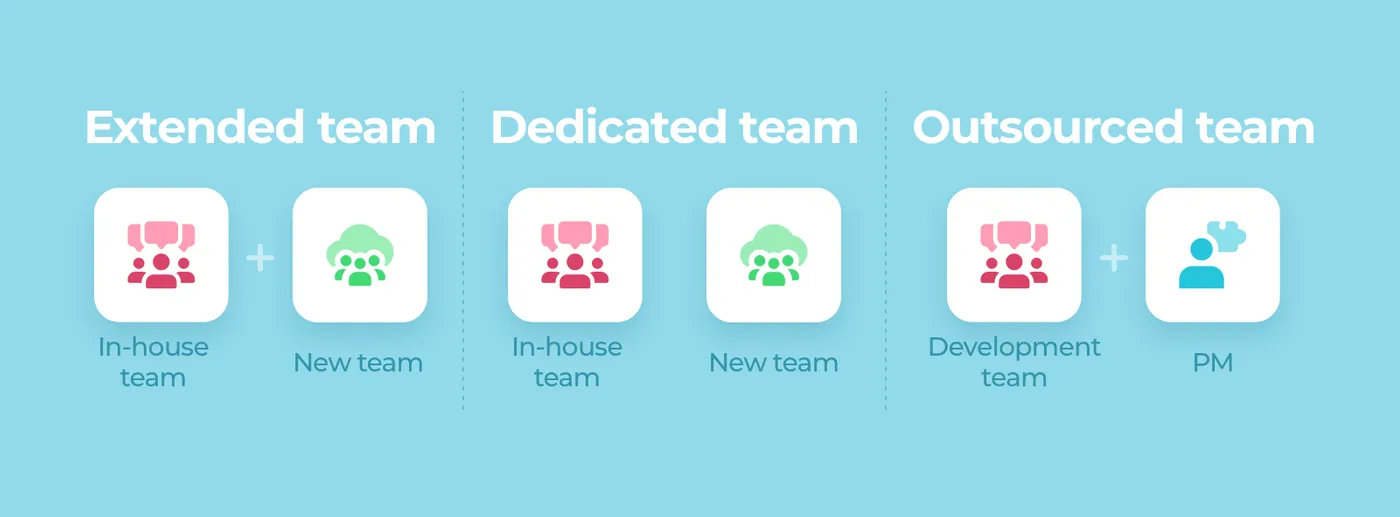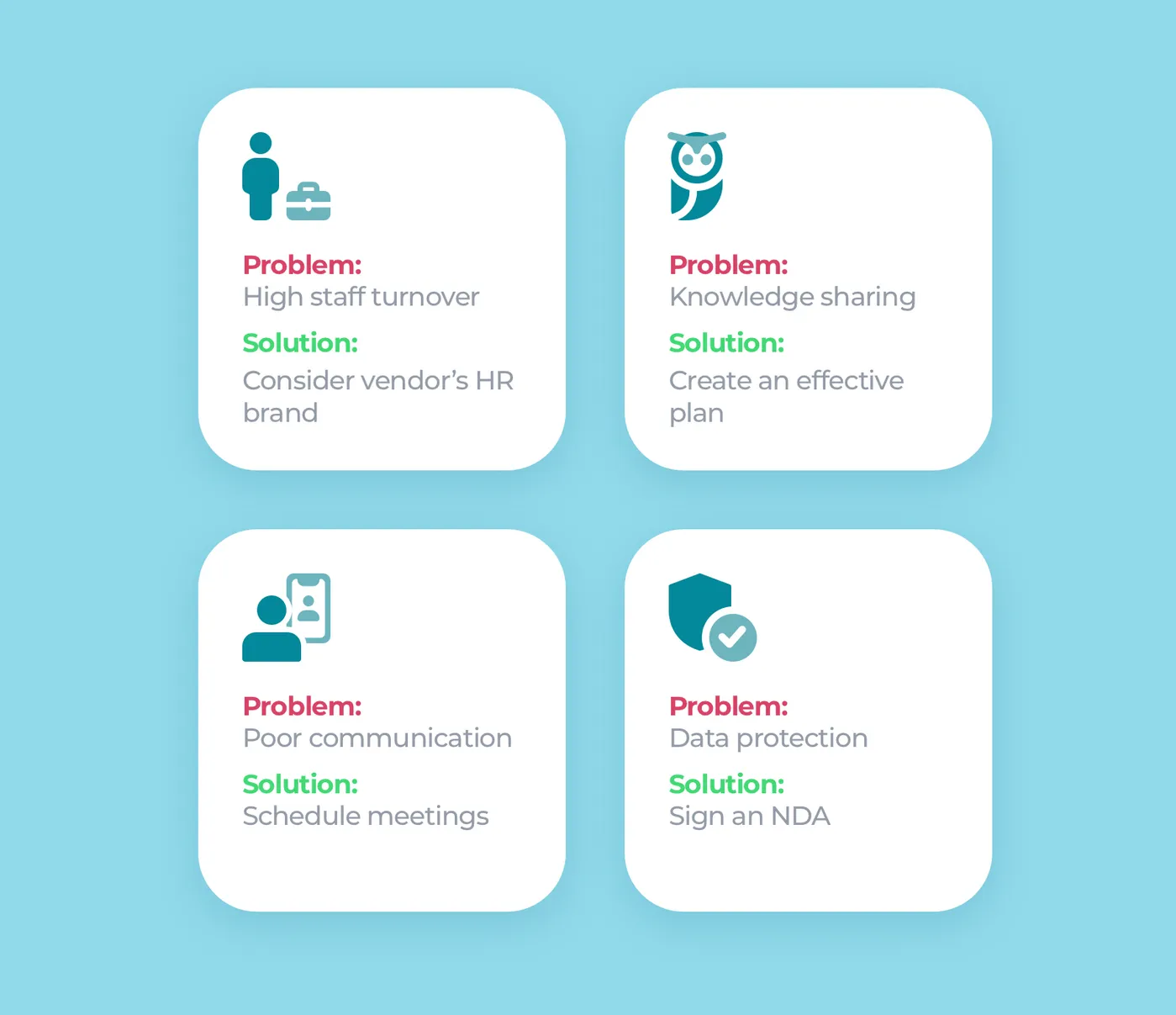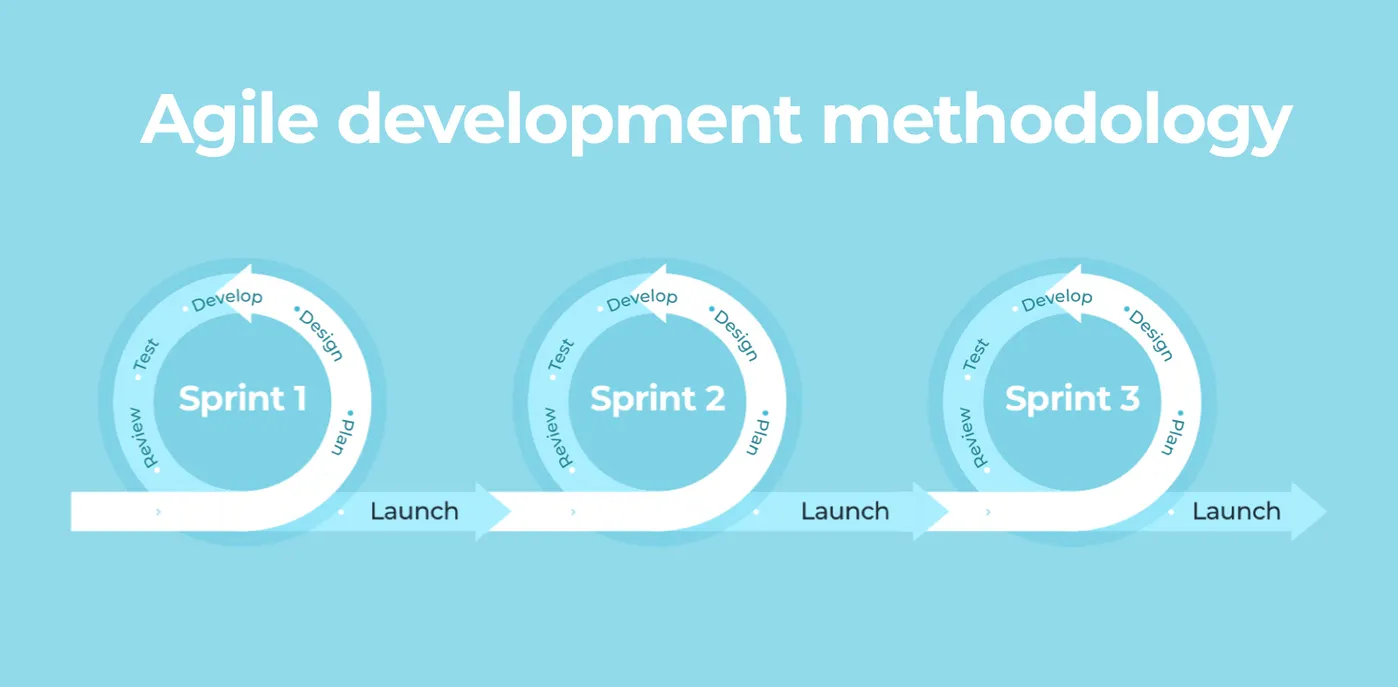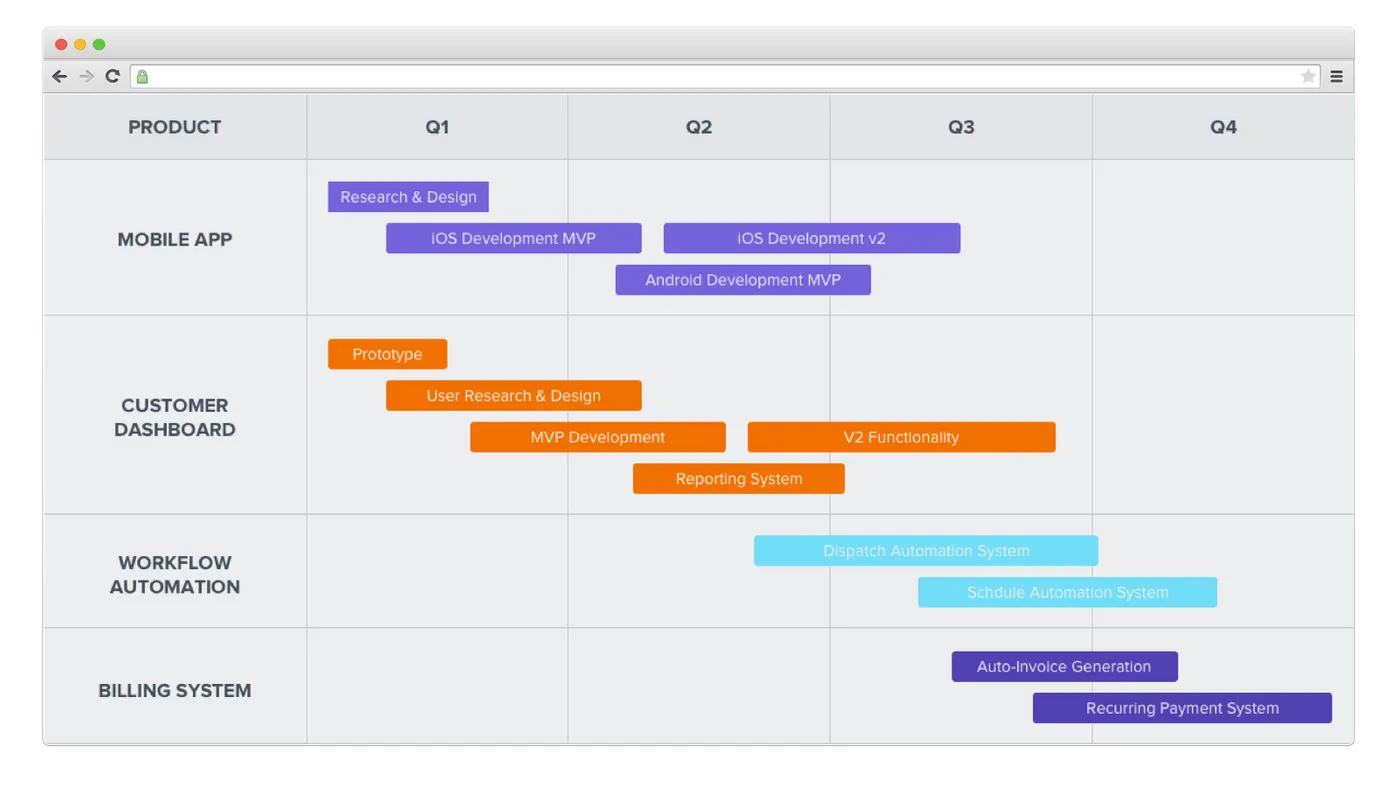Guide to Managing Offshore Development Team
Updated 21 Apr 2023
9 Min
2706 Views
Offshore development teams are a cost-effective model. There’s no need to pay for rent, equipment, and software licenses. A vast talent pool of software engineers from different countries and low hourly rates are among other notable advantages.
However, the question arises — how to manage an offshoring software development team effectively. There are many problems you can face during such cooperation, like poor communication and data protection. Due preparation will let you know how to solve all these issues.
Here’s what you’re going to learn:
Types of Offshore Development Teams
If you want to outsource software development services, there are three cooperation models to consider: an extended team, a dedicated team, and an outsourced team. The primary difference between them lies in project management.

Types of offshore development teams
- Extended team. This model stands for adding several software engineers to the existing in-house team. In this case, project management is on your shoulders. The extended team is perfect for short-time cooperation if you need to scale a project fast and meet strict deadlines.
- Dedicated team. Dedicated development means hiring tech specialists to do a particular job. Hire dedicated teams doesn’t usually mean cooperation with in-house programmers and management on the customer's side. When the project is over, the cooperation also comes to an end.
- Outsourced team. Your vendor is fully in charge of managing a development team and making sure the product will be finished in time. The team has a Project Manager who’s responsible for managing the offshore development team.
| Difference | Extended team | Dedicated team | Outsourced team |
Project development | Add developers to the in-house team to scale it | Hire specialists to do a particular job | Cooperate with the team to develop the project (from planning to release) |
Project management | On the customer's side | On the customer's side | Project Manager is a part of the team |
Long-term cooperation | Perfect | Perfect | Perfect |
Problems You May Face Working With Offshore Development Teams
Managing offshore software development teams can be tricky. There are a lot of issues that you have to consider beforehand. Communication-related difficulties are probably the most widespread.
Let’s take a look at all of them.
High Staff Turnover
It isn’t very easy to manage a team where specialists come and go all the time. Given that you need to onboard each new team member, it leads to development delays.
How to solve it?
Looking for a software development vendor, you should pay attention to the HR brand. You should check if the employees work in a comfortable environment, have the required equipment, and plenty of opportunities for self-development. If the chosen vendor has a low turnover rate, it means that employees are satisfied with their working conditions.
Want to hire an offshore team?
Contact us to find out how we work and collect the right team for your project.
Knowledge Sharing
To get significant results, you need to share knowledge with the offshore development team. When cooperating with the outsourced team, you have to discuss all the required development issues with a Project Manager who shares information with the team. For example, you can share a design style guide, ready wireframes, a specification, and more.
How to solve it?
You should think over an effective knowledge sharing plan. With the project manager’s help, you analyze how fast the team can start the project development. You need to consider various stages like wireframes, design, development, and quality assurance. Simply saying, a knowledge sharing plan stands for the plan of showing documentation, code, design, and other parts of the project.
Development teams usually have daily or weekly meetings where they discuss the tasks to do and talk about blockers.
Want to learn more about software development? We’ve already explained our approach to the software development process step by step.
Poor Communication
A lot of companies worry about the language barrier and communication problems. If you and your team are on different continents, you’ll face a time zone difference. Poor communication may lead to project delays and misunderstanding of goals and requirements.
How to solve it?
The solution is quite simple — you should schedule meetings beforehand. There are many communication tools like Slack, Skype, and Gmail that’d let you stay in touch and follow the development process.
As for the language barrier, it becomes a thing of the past since IT specialists usually have fluent English.

Countries and their culture types
Data Protection
Working with offshore software development teams, you can lack face-to-face communication. As a result, you can think that your data, such as a project idea and business requirements, isn’t well-protected and can be stolen.
How to solve it?
To sleep tight, you should sign an NDA agreement with your vendor. This contact covers such development aspects as the procedure of data collection, transfer, access, and more.
Also, mind that software development companies should follow the EU General Protection Regulation (GDPR) or the California Consumer Privacy Act (CCPA) in certain cases.
Note! Cleveroad has already developed the framework that helps us comply with GDPR and CCPA.

Problems you may face and their solutions
How to Manage Offshore Software Development Team: Tips to Follow
Managing offshore development teams requires certain preparations. Below, we’re outlining some tips making the cooperation process more convenient.
Tip #1. Define the Scope of Work
Before starting the development, it’s required to set the amount of work that must be done by specific data. This step lets the team understand the project requirements and business goals. The scope of work should contain the feature list and the deadlines.
With the scope of work, the team can divide tasks into parts called sprints to make the development process more structured. Additionally, such a method allows for flexible project changes, depending on the user's feedback.
For example, at Cleveroad, we use Agile development methodology. It means that we divide the development into sprints, a period when a team has to finish a certain amount of work.
Each sprint takes two weeks (ten working days) and starts with a planning meeting. The team and the client discuss what tasks to do during the sprint. Each sprint is followed by a demo where the team shows the work done during the sprint and asks for feedback.

Agile development methodology
Tip #2. Build a Product Roadmap
The product roadmap is a visual step-by-step plan for project development. It consists of upcoming features, tech peculiarities, and shows how the product will evolve in the future. The product roadmap is perfect for attracting investments. It translates features and technologies into a business language understood for investors.
It’s common to create two roadmaps: external (for customers and investors) and internal (for offshore development team).
- For customers and investors. This roadmap shows what you’re going to do and how you’re going to do it. It should be straightforward and understandable.
- For the development team. This roadmap is more detailed to ensure that team members are on the same page.
Explaining how to build a product roadmap based on the needs of your team and investors (best roadmapping tools included).

Product roadmap
Tip #3. Schedule Regular Demos
It’s better to schedule regular demos to control how the development process goes and make changes (if necessary). Demo stands for showing the completed part of the work to the client.
Using the Agile development method, at Cleveroad, we have a product demo at the end of each sprint (day 10). Before the demo, our QA team checks all the features developed during this sprint. Also, we do regressive tests to ensure that the whole app works properly, and new functions don’t conflict the old ones.
Product owners need to test the product demo (for example, till the end of the working day). If the clients find any issues or bugs, they list them for the development team to fix.
Tip #4. Use Collaboration Tools
To follow the development process and be up to date, you should use project management tools. With the help of project tracking software, you can see how the offshore development team performs and how much time they spend per task.
The most popular tools for tracking are:
- Jira
- Trello
- Kantree
As a result, you’re completely involved in the project development process. These tools can’t replace daily meetings or planning meetings. Still, they make the development process more structured and transparent.
Tip #5. Pick a Perfect Meeting Schedule
Managing offshore development teams, you need to keep in touch constantly. There are a many tools improving communication with the team:
- Slack
- Gmail
- Outlook
- Skype
- Google Hangouts
- Zoom
You should create a meeting schedule with your development team. For example, you can have a video meeting with a Project Manager once a week. During this meeting, you can ask questions about the development or suggest changes and improvements. On the other hand, the Project Manager tells you how the development goes and clarifies any possible issues.
You can schedule meetings with the whole offshore development team (designers, developers, QA engineers, and the Project Manager).
It’s also possible to visit the team in the office. You can fly to the destination of your development team. That’ll let you speak to your team personally.
Explore the mobile app development offshore details
How We Manage Offshore Development Teams at Cleveroad
Being an outsourced software development company, we have a lot of experience in project management.
We use these approaches to make our work transparent and straight-forward:
- Agile development methodology. We divide project development into sprints. The team develops a set amount of work during each sprint and shows it to the client (demo). It lets us make changes to the project if necessary.
- Daily meetings. Our development team conducts daily meetings every morning. They discuss what tasks they’re planning to finish during the day so that QA engineers can check them.
- Scheduled meetings with a client. Every week Project Managers speak to customers to keep them up-to-date with the made changes. Also, PMs send messages to the client during the week.
Looking for the development team?
We can pick the best specialists for your project based on your business goals and requirements.
If you want to outsource software development services, there are three cooperation models to consider: an extended team, a dedicated team, and an outsourced team. The primary difference between them lies in project management. In the first and second teams, project management is on the customer’s shoulders. On the other hand, the outsourced team has a Project Manager to manage the development process.
There are many platforms that aggregate information about vendors that offer offshore software development teams. The most famous are:
- Clutch
- GoodFirms
- IT Firms
- 99firms
Below, there are some tips making the cooperation process more convenient.
- Tip #1. Define the scope of work. Before starting the development, it’s required to set the amount of work that must be done by specific data.
- Tip #2. Build a product roadmap. The product roadmap is a visual step-by-step plan for project development. It consists of upcoming features, tech peculiarities, and shows how the product will evolve in the future.
- Tip #3. Schedule regular demos. It’s better to schedule regular demos to control how the development process goes and make changes (if necessary). Demo stands for showing the completed part of the work to the client.
- Tip #4. Use collaboration tools. With the help of project tracking software, you can see how the offshore development team performs and how much time they spend per task (for example, Jira and Trello).
- Tip #5. Pick a perfect meeting schedule. You should create a meeting schedule with your development team. For example, you can have a video meeting with a Project Manager once a week. During this meeting, you can ask questions about the development or suggest changes and improvements.
There are two primary point to consider — regular demos (showing the completed part of the work to the client) and meeting schedule (regular meetings or video calls with your development team).

Evgeniy Altynpara is a CTO and member of the Forbes Councils’ community of tech professionals. He is an expert in software development and technological entrepreneurship and has 10+years of experience in digital transformation consulting in Healthcare, FinTech, Supply Chain and Logistics
Give us your impressions about this article
Give us your impressions about this article
Comments
4 commentsthanks for sharing)
cool.
I want to cooperate with offshore development team. Thank you for sharing such important information. I'd love to use your tips and tricks during managing my future team.
Hi) I liked your text. Of course, managing offshore development teams can be a struggle. However, you offered a bunch of cool solutions for the greatest problems. That's cool!